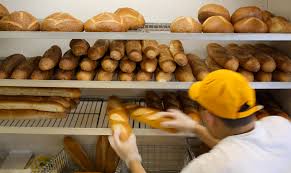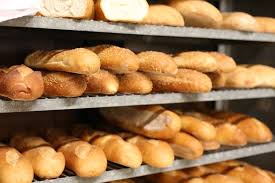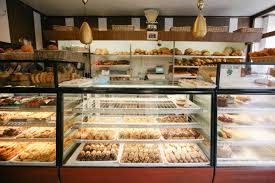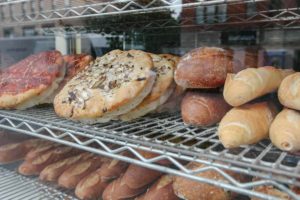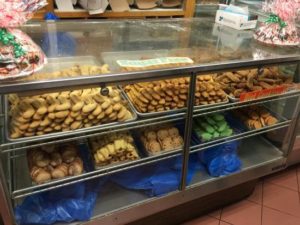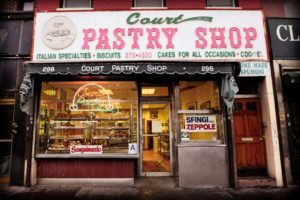A few weeks ago, I went shopping at Caputo’s Bakery Shop, and Court Street Pastry in my old Carroll Gardens neighbourhood. During these hard times, there is nothing like ciabatta bread and sweet delicious pastries to bite back on that locked-in feeling. Thankfully, bakeries are considered essential businesses.
Stopping in at Caputo’s first, I recognized a neighbour, Lorraine, who had lived across the street from me when I lived above Court Street Pastry. These days you can’t tell who’s who with everyone wearing masks. After I noticed her distinct bright red hair and then her strong Brooklyn accent, I shouted hello.
“What brings you back here, stranger?” she asked.
“Do you know what’s it’s like to go without ciabatta for a year?” I asked, rolling my eyes.
“This place draws you back.”
We exchanged updates on our families. I told her about how my older son, who was half my height back then, is now six-feet-four-inches.
“The neighbourhood looks so different,” I said.
“It has changed a lot. Everything’s more expensive,” she added, rubbing her thumb and first two fingers together.
“The bakeries seem the same.”
“They’re still here,” she said. “But the new neighbours aren’t as big into these kinds of bread and pastries.”
“When I lived here, people used to line up around the block on holidays to make their pilgrimage. They drove in from New Jersey, Staten Island, all over the New York area.”
“Those were the days,” she said.
“Do they still get the daily run of customers?”
“Well, many of the old-timers are gone. The people here now don’t buy in bag loads; they buy by the cookie, or by a single loaf of bread.” Standing a good five feet tall, she waved her short arms from her round body as she spoke. A golden cross with the delicate body of Jesus nailed to it glittered from a chain around her neck.
Bakeries used to be everywhere
When I lived above Court Street Pastry, the neighbourhood was dominated by bakeries. Every morning, I’d wake up to the aromas of cheesecakes and almond-scented spices wafting in from the store below. By the time I got out of bed, the bakers had worked almost a full day. I was also smitten by the smell of fresh bread coming from Caputo’s across the street. It was like my brain slept in a sugar paradise, flooded by tidal waves of cookies and bread smashing together in my dreams.
Being so close together, each bakery has a different speciality. While Court Street makes pastries and confections, Caputo’s specializes in bread and cookies. Baked on-premises, Caputo’s makes ciabatta and loaves stuffed with cheese and or prosciutto. Fresh out of the oven, ciabatta is like eating doughy clouds. When you yank off chunks of the flat, long bread, it is fluffy and soft, practically melting in your mouth. You hardly chew it. The Prosciutto Bread is stuffed with wedges of prosciutto and baked with cheese.
Back then, I frequently saw the twin brothers who did most of the baking for Caputo’s. They were short and stout, with curly light brown hair matting their strong, square faces. Built with thick forearms and stout legs, they looked Promethean. The twins frequently disappeared into the deep recesses of the bakery, perhaps even below the surface, nearer to the core of the earth, I imagined. Their faces red, I would see them emerge with trays of freshly baked breads on roller carts.
As if to not compete, Court Street doesn’t make breads like Caputo’s. They make sweets like canoli, sfogliatella, cream puffs, and cookies, some smothered in chocolate, some dipped in colorful sprinkles. Court Street’s crowning glory is the sfogliatella, or Lobster Tail, as it is also known, which has a croissant like exterior, though crunchier and more layered. Filling the inside is a mixture of whipped cream and custard, which must include near a pound of sugar. They also make a Sicilian specialty called mustazzola. This confection is a flat brown cookie with lighter-colored dough molded in the form of the Baby Jesus lying on top. You only find mustazzola displayed on Easter and Christmas.
When I paid for bread at Caputo’s, ready to head over to Court Street Pastry, Lorraine and I looked at each other through our masks.
Yeast, but no hugs during pandemic
“I would give you a hug, but you know,” said Lorraine.
I nodded my head in agreement.
“It was great to see you. Say hi to the family.”
It felt incredibly sad to just wave from six feet away.
As I left the store, I thought to myself about the uniqueness of these bakeries. They come from a time and an era in New York City that has passed. Carroll Gardens is no longer a neighborhood of Southern Italians.
When I lived there, I remember seeing dumpsters all over, as new owners gutted their new homes, discarding much of the mid twentieth century furniture. With their arrival, the neighborhood changed completely. The family owned retail vacuum store disappeared. The garment store, where locals shopped to purchase fabric and sewing materials, was gone too. They were, perhaps, too common for the population moving in. And the little specialty shops, like the Salumerias and Italian food stores, closed as well. The people who moved in didn’t buy that kind of food, at least in the same amounts.
The truth of the matter is that I often felt caught between these two worlds. I grew up in Long Island City. While it was not an Italian American neighborhood, it was blue-collar like Carroll Gardens. The stores in my neighborhood were hardware shops, shoemakers, and video rental places. There were not French Bistros. When I left Queens, it was an insular place. Most of my friends did not go to college, or travel to Europe in summer. I escaped to experience the bigger world “out there,” first living in California, then in Manhattan. Then, when I moved to Brooklyn, mainly out of circumstance, the boroughs were fast changing. I became part of that change. I become one of the colonizers. One of the occupiers.
I have one memory from a few years ago that says it all. Standing online at Caputo’s, an old lady, maybe five feet tall, shouted her order over the counter. “I’ll take three ciabattas, three Prosciutto Breads, four pounds of cookies, in two boxes.” I wondered how she’d carry it home. Then a young woman, next in line, made her request. “Can I just get a few of these in a bag,” she said, pointing at chocolate smothered cookies covered with sprinkles.
Caputo’s Bakery Shop: 329 Court St, Brooklyn, NY 11231 | (718) 875-6871
Court Street Pastry: 298 Court St, Brooklyn, NY 11231 | (718) 875-4820


